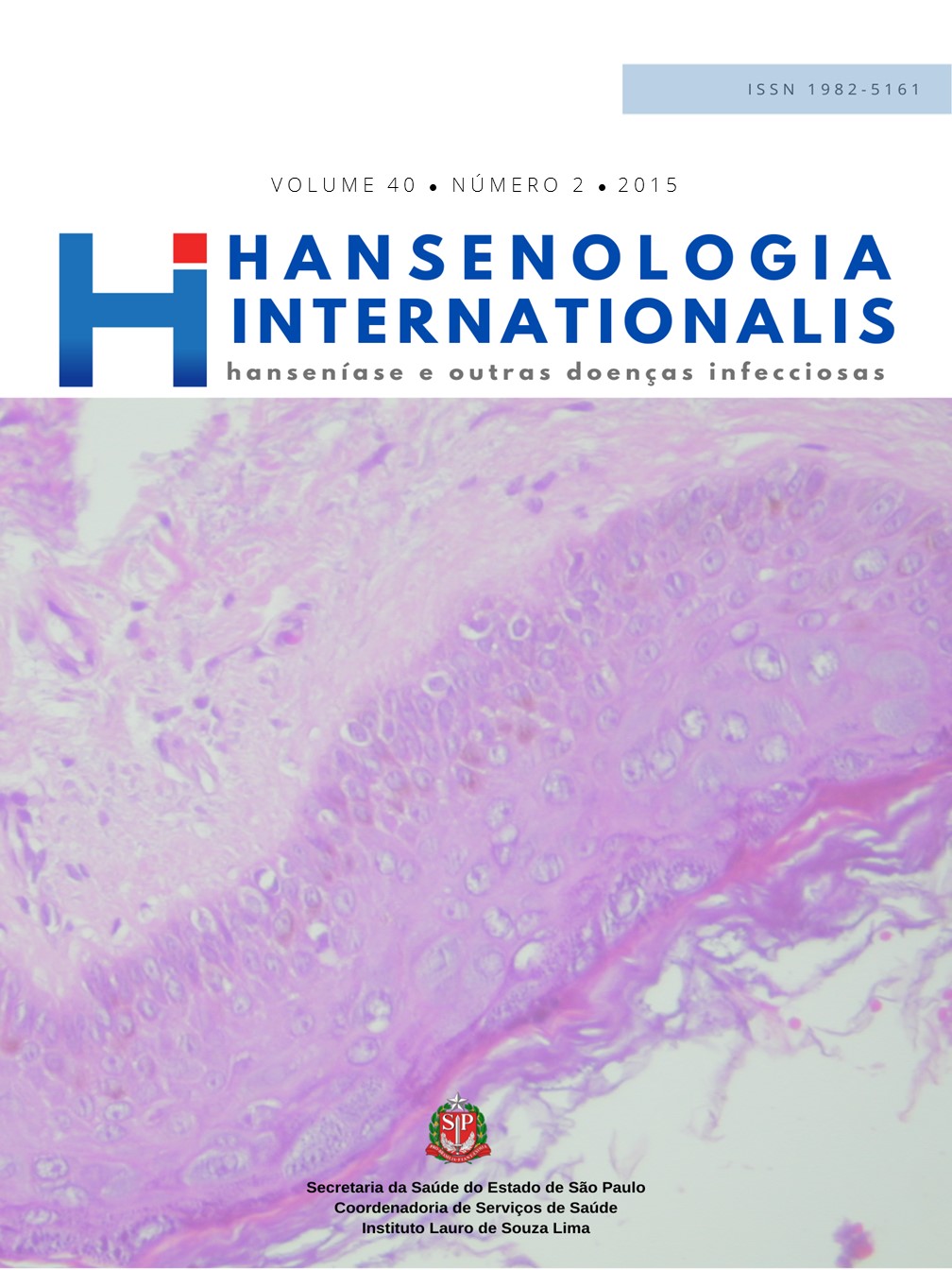Abstract
Leprosy in the state of Pará is worrying as the coefficient of detection in under 15-year olds is classified as hyperendemic. This indicator reflects recent transmission of the disease. This study aimed to analyze the epidemiological situation of leprosy in under 15-year-old children in the city of Belém, Pará from 2003 to 2013. This is a quantitative, descriptive and retrospective study of the number of cases of children with leprosy using data from the Notifiable Diseases Information System (SINAN). The results show an average annual detection rate of leprosy in under 15-year olds of 34.9 per 100,000 inhabitants, classifying the disease as hyperendemic. Most patients were male with a frequency of 55.8% (266). The predominant mode of detection was referrals (54.7% - 261) and the commonest clinical form identified was tuberculoid in 38.6% (184) of the cases. On average, each case recorded 4.36 contacts giving a grand total of 2082 contacts. As for the contacts investigated, precarious parameter of less than 50% predominated. Brazil is a country of great proportions and many geographic peculiarities; Belem, Pará State is not so different. The population has difficultly accessing health services and, consequently, there is difficulty diagnosing and treating leprosy in this region. Knowledge on the epidemiological situation of under 15-year-old children is important to plan strategies that contribute to the control of this regional endemics.
References
2 Lobato DC. Avaliação das ações da vigilância de contatos de pacientes com hanseníase no município de Igarapé-Açu – Pará [dissertação]. Rio de Janeiro: Fundação Oswaldo Cruz, Escola Nacional de Saúde Pública; 2011. [acesso 2014 nov 20]. Disponível em: http://bases.bireme.br/cgi-bin/wxislind.exe/iah/online/?IsisScript=iah/iah.xis&src=google&base=LILACS&lang=p&nextAction=lnk&exprSearch=638282&indexSearch=ID
3 Ministério da Saúde (BR), Secretaria de Vigilância em Saúde, Departamento de Vigilância em Doenças Transmissíveis. Plano integrado de ações estratégicas de eliminação da hanseníase, filariose, esquistossomose e oncocercose como problema de saúde pública, tracoma como causa de cegueira e controle das geohelmintíases : plano de ação 2011-2015. Brasília: Ministério da Saúde; 2012.
4 Brasil. Ministério da Saúde. Portaria GM nº 149, de 3 de fevereiro de 2016. Aprova as Diretrizes para Vigilância, Atenção e Controle da Hanseníase. Saude Legis. Brasília, 04 de fevereiro de 2016.
5 Norman G, Joseph GA, Udayasuriyan P, Samuel P, Venugopal M. Leprosy case detection using school children. Lepr Rev [Internet]. 2004 [acesso 2014 nov 20];75(1):34-9. Disponível em: http://www.ncbi.nlm.nih.gov/pubmed/15072124
6 Pires CAA, Malcher CMSR, Abreu JMC Junior, Albuquerque TG, Correa IRS, Daxbacher ELR. Leprosy in children under 15 years: the importance of early diagnosis. Rev Paul Pediatr [Internet]. 2012 [acesso 2016 jun 26];30(2):292-5. Disponível em: http://www.scielo.br/scielo.php?pid=S0103-05822012000200022&script=sci_arttext.
7 Ministério da Saúde (BR), Secretaria de Vigilância em Saúde. Situação Epidemiológica Hanseníase no Brasil - 2011. Brasília: Ministério da Saúde; 2012.
8 Vieira CSCA, Soares MT, Ribeiro CTSX, Silva LFG. Avaliação e controle de contatos faltosos de doentes com hanseníase. Rev Bras Enferm [Internet]. 2008 [acesso 2014 nov 20];61(esp):682-8. Disponível em: http://www.scielo.br/scielo.php?pid=S0034-71672008000700005&script=sci_arttext
9 Costa FM Junior; Maia ACB. Concepções de homens hospitalizados sobre a relação entre gênero e saúde. Psicol [Internet]. 2009 [acesso 2014 nov 19];25(1):55-63. Disponível em: http://www.scielo.br/pdf/ptp/v25n1/a07v25n1.pdf
10 Ministério da Saúde (BR). Vigilância em Saúde: situação epidemiológica de hanseníase no Brasil. Brasília: Ministério da Saúde; 2008.
11 World Health Organization. Enhanced global strategy to further reduce burden of leprosy: plan period: 2011-2015 [Internet]. Geneva: WHO; 2009 [citado em 2014 Nov 20]. Disponível em: http://www.searo.who.int/entity/global_leprosy_programme/documents/enhanced_global_strategy_2011_2015_operational_guidelines.pdf12 Hinrichsen SL, Pinheiro MRS, Jucá MB, Rolim H, Danda GJN, Danda DMR. Aspectos epidemiológicos da hanseníase na cidade de Recife, PE em 2002. An Bras Dermatol. 2004 Ago;79(4):413-21.
13 Imbiriba EB, Hurtado-Guerrero JC, Garnelo L, Levino A, Cunha MG, Pedrosa V. Epidemiological profile of leprosy in children under 15 in Manaus (Northern Brazil), 1998-2005. Rev Saúde Pública. 2008;42(6):1021-6.

This work is licensed under a Creative Commons Attribution 4.0 International License.
